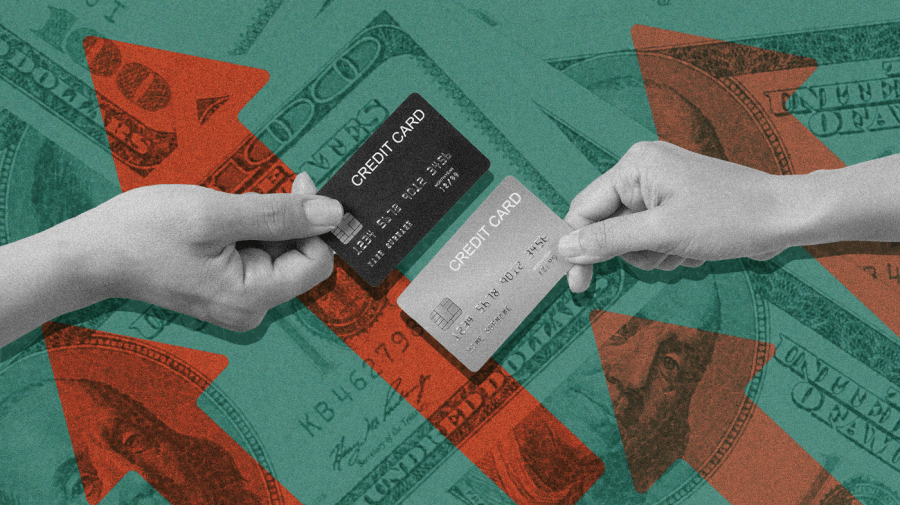Business
‘It’s just gonna get paid when it gets paid’: Balance-carrying cardholders crunched by Fed rate hikes on August 2, 2023 at 10:00 am Business News | The Hill

Americans with credit card debt are caught in the crossfire of the Federal Reserve’s battle to bring down inflation.
The average annual percentage rate (APR) for credit cards hit 22.39 percent during the second quarter of 2023, up 3.5 percentage points from the same period last year, according to a new study by WalletHub.
5 takeaways as the Fed reignites its inflation fight
“The current average credit card APR is the highest it’s ever been in the past two decades due to the recent Fed rate hikes,” WalletHub analyst Jill Gonzalez told The Hill.
Gonzalez anticipates credit card APR will increase further as a result of the Fed’s decision to raise interest rates again last week.
The Fed has hiked interest rates 11 times since March 2022, raising its baseline interest rate last week to a 22-year high. Fed rate hikes are meant to slow the economy and reduce inflation by making it more expensive to borrow and owe money.
While rates on some loans — such as mortgages — are only influenced by Fed hikes, credit card companies usually move rates in lockstep with the Fed.
Those higher rates are now deepening the debts many Americans are facing.
Caitlin Hogan, a 32-year-old case manager in central Kansas, told The Hill she had to put some unexpected expenses on one of her credit cards and is focused on paying off another one.
“I do not want to slip down the very slippery slope!” Hogan wrote.
Hogan’s plan is to put a little extra money towards that balance, but said “it’s just gonna get paid when it gets paid.”
Credit card debt on the rise
The national credit card balance is around $1 trillion, more cardholders are carrying a balance than ever before, and the average household carries $10,000 in credit card debt.
Riley Bookout, a graduate student at Texas A&M University, told The Hill he’s more cautious about what he puts on his credit card.
‘Don’t see the point of it’: Consumers feel the pinch as Fed raises rates again
“If I were to miss a payment — and I don’t make a ton of money — it could hurt,” Bookout said.
“I think it’s concerning that we’re having to raise the interest rate at all anymore,” he added. “From the outside, it feels like the economy’s doing rather well.”
Middle and low-income families were hardest hit by high inflation that made it difficult to afford basic needs including food, gas and housing, Gonzalez said. While inflation is far lower now than it was last year, the nation’s total credit card debt lays bare “the almost devastating effects of these increases.”
‘A long way to go‘ before rates come down
Inflation has plummeted from its peak at 9 percent year-over-year in June 2022 to 3 percent in June 2023, but Fed Chair Jerome Powell warned last week inflation has a “long way to go” before it falls to the Fed’s 2 percent inflation target.
Powell said the Fed may decide to raise interest rates again in September if inflation does not appear to be in check, and will likely keep rates high until it is quashed for good.
Powell: Housing market has ‘a ways to go’ before prices cool
“Inflation has proved repeatedly has proved stronger than we and other forecasters have expected and at some point that may change. We have to be ready to follow the data,” he said.
Gonzalez expects more hikes before the end of the year as the Fed works to cool the economy, and she anticipates credit card debt and the unemployment rate will continue to climb over the next few months.
“There’s still uncertainty about whether we’ll face a recession in the second half of the year or not, but it’s important for consumers to start saving up regardless,” Gonzalez said.
How to manage credit card debt
While it can be difficult to save when the interest keeps piling up, Candace Lee, vice president and client advisor at Glassman Wealth Services, said there are several options for tackling higher credit card debt.
“Anytime there’s excess cash that you have in your bank account, just focus on paying down the one that has the highest interest rate,” Lee said. “You’re basically just placing money in interest rate fees every time you kind of just leave that one to build.”
Cardholders may also focus on paying off the credit card with the highest balance, or a smaller balance that’s easy to pay off “so you kind of feel like you’re making progress.”
Lee does not usually recommend her clients to refinance their credit card debt. She said there may be fine print that’s missed that could make it even harder to pay down their debt.
If possible, it’s important to make the minimum payments on credit card — and to make them on time — to avoid hits to your credit score and late fees.
Lee says in the immediate term, she tries to be as encouraging as she can when working with clients who are struggling with credit card debt.
“Some people can’t help having credit card debt just based on their income,” she said.
Lee added that getting into the habit of evaluating your accounts, expenses and income as you have extra cash to pay off credit card debt “is just a smart strategy.”
Tackling late fees
The Consumer Financial Protection Bureau (CFPB) proposed a new rule in February to cap credit card late fees it estimates cost Americans around $12 billion each year.
If the proposed rule is finalized, late fees would drop from as much as $41 per violation to $8, among other provisions.
The CFPB estimates this rule would reduce late fees by as much as $9 billion annually, but banks and credit unions are lining up against the proposal.
In a May letter to the CFPB, the American Bankers Association, the Consumer Bankers Association and the National Association of Federally-Insured Credit Unions warned credit cards could get more expensive and difficult to get if the rule were implemented.
The associations also argued late fees are an “important incentive” to encourage on-time payments, minimize the risk of default and support good credit.
Business Americans with credit card debt are caught in the crossfire of the Federal Reserve’s battle to bring down inflation. The average annual percentage rate (APR) for credit cards hit 22.39 percent during the second quarter of 2023, up 3.5 percentage points from the same period last year, according to a new study by WalletHub. 5…
Business
Why 9 Million Americans Have Left

The Growing American Exodus
Nearly 9 million Americans now live outside the United States—a number that rivals the population of several states and signals a profound shift in how people view the American dream. This mass migration isn’t confined to retirees or the wealthy. Thanks to remote work, digital nomad visas, and mounting pressures at home, young professionals, families, and business owners are increasingly joining the ranks of expats.

Rising Costs and Shrinking Wallets
Living in the US has become increasingly expensive. Weekly grocery bills topping $300 are not uncommon, and everyday items like coffee and beef have surged in price over the last year. Rent, utilities, and other essentials also continue to climb, leaving many Americans to cut meals or put off purchases just to make ends meet. In contrast, life in countries like Mexico or Costa Rica often costs just 50–60% of what it does in the US—without sacrificing comfort or quality.
Health Care Concerns Drive Migration
America’s health care system is a major trigger for relocation. Despite the fact that the US spends more per person on health care than any other country, millions struggle to access affordable treatment. Over half of Americans admit to delaying medical care due to cost, with households earning below $40,000 seeing this rate jump to 63%. Many expats point to countries such as Spain or Thailand, where health care is both affordable and accessible, as a major draw.

Seeking Safety Abroad
Public safety issues—especially violent crime and gun-related incidents—have made many Americans feel unsafe, even in their own communities. The 2024 Global Peace Index documents a decline in North America’s safety ratings, while families in major cities often prioritize teaching their children to avoid gun violence over simple street safety. In many overseas destinations, newly arrived American families report a significant improvement in their sense of security and peace of mind.
Tax Burdens and Bureaucracy
US tax laws extend abroad, requiring expats to file annual returns and comply with complicated rules through acts such as FATCA. For some, the burden of global tax compliance is so great that thousands relinquish their US citizenship each year simply to escape the paperwork and scrutiny.
The Digital Nomad Revolution
Remote work has unlocked new pathways for Americans. Over a quarter of all paid workdays in the US are now fully remote, and more than 40 countries offer digital nomad visas for foreign professionals. Many Americans are leveraging this opportunity to maintain their US incomes while cutting costs and upgrading their quality of life abroad.

Conclusion: Redefining the Dream
The mass departure of nearly 9 million Americans reveals deep cracks in what was once considered the land of opportunity. Escalating costs, inaccessible healthcare, safety concerns, and relentless bureaucracy have spurred a global search for better options. For millions, the modern American dream is no longer tied to a white-picket fence, but found in newfound freedom beyond America’s borders.
Business
Will Theaters Crush Streaming in Hollywood’s Next Act?

Hollywood is bracing for a pivotal comeback, and for movie lovers, it’s the kind of shake-up that could redefine the very culture of cinema. With the freshly merged Paramount-Skydance shaking up its strategy, CEO David Ellison’s announcement doesn’t just signal a change—it reignites the passion for moviegoing that built the magic of Hollywood in the first place.

Theatrical Experience Roars Back
Fans and insiders alike have felt the itch for more event movies. For years, streaming promised endless options, but fragmented attention left many longing for communal spectacle. Now, with Paramount-Skydance tripling its film output for the big screen, it’s clear: studio leaders believe there’s no substitute for the lights, the hush before the opening credits, and the collective thrill of reacting to Hollywood’s latest blockbusters. Ellison’s pivot away from streaming exclusives taps deep into what unites cinephiles—the lived experience of cinema as art and event, not just content.
Industry Pulse: From Crisis to Renaissance
On the financial front, the numbers are as electrifying as any plot twist. After years of doubt, the box office is roaring. AMC, the world’s largest theater chain, reports a staggering 26% spike in moviegoer attendance and 36% revenue growth in Q2 2025. That kind of momentum hasn’t been seen since the heyday of summer tentpoles—and it’s not just about more tickets sold. AMC’s strategy—premium screens, with IMAX and Dolby Cinema, curated concessions, and branded collectibles—has turned every new release into an event, driving per-customer profits up nearly 50% compared to pre-pandemic norms.
Blockbusters Lead the Culture
Forget the gloom of endless streaming drops; when films like Top Gun: Maverick, Mission: Impossible, Minecraft, and surprise hits like Weapons and Freakier Friday draw crowds, the industry—and movie fans—sit up and take notice. Movie-themed collectibles and concession innovations, from Barbie’s iconic pink car popcorn holders to anniversary tie-ins, have made each screening a moment worth remembering, blending nostalgia and discovery. The focus: high-impact, shared audience experiences that streaming can’t replicate.
Streaming’s Limits and Studio Strategy
Yes, streaming is still surging, but the tide may be turning. The biggest franchises, and the biggest cultural events, happen when audiences come together for a theatrical release. Paramount-Skydance’s shift signals to rivals that premium storytelling and box office spectacle are again at the center of Hollywood value creation. The result is not just higher profits for exhibitors like AMC, but a rebirth of movie-going as the ultimate destination for fans hungry for connection and cinematic adventure.

Future Forecast: Culture, Community, and Blockbuster Dreams
As PwC and others warn that box office totals may take years to fully catch up, movie lovers and industry leaders alike are betting that exclusive theatrical runs, enhanced viewing experiences, and fan-driven engagement are the ingredients for long-term recovery—and a new golden age. The Paramount-Skydance play is more than a business move; it’s a rallying cry for the art of the theatrical event. Expect more big bets, more surprises, and—finally—a long-overdue renaissance for the silver screen.
For those who believe in the power of cinema, it’s a thrilling second act—and the best seat in the house might be front and center once again.
Business
Why Are Influencers Getting $7K to Post About Israel?

Influencers are being paid as much as $7,000 per post by the Israeli government as part of an expansive and sophisticated digital propaganda campaign. This effort is designed to influence global public opinion—especially among younger social media users—about Israel’s actions in Gaza and to counter critical narratives about the ongoing humanitarian situation.

How Much Is Being Spent?
Recent reports confirm that Israel has dedicated more than $40 million this year to social media and digital influence campaigns, targeting popular platforms such as TikTok, YouTube, and Instagram. In addition to direct influencer payments, Israel is investing tens of millions more in paid ads, search engine placements, and contracts with major tech companies like Google and Meta to push pro-Israel content and challenge critical coverage of issues like the famine in Gaza.
What’s the Strategy?
- Influencer Contracts: Influencers are recruited—often with all-expenses-paid trips to Israel, highly managed experiences, and direct payments—to post content that improves Israel’s image.
- Ad Campaigns: State-backed ad buys show lively Gaza markets and restaurants to counter global reports of famine and humanitarian crisis.
- Narrative Management: These posts and ads often avoid overt propaganda. Instead, they use personal stories, emotional appeals, and “behind the scenes” glimpses intended to humanize Israel’s side of the conflict and create doubt about reports by the UN and humanitarian agencies.
- Amplification: Paid content is strategically promoted so it dominates news feeds and is picked up by news aggregators, Wikipedia editors, and even AI systems that rely on “trusted” digital sources.
Why Is This Happening Now?
The humanitarian situation in Gaza has generated increasing international criticism, especially after the UN classified parts of Gaza as experiencing famine. In this environment, digital public relations has become a primary front in Israel’s efforts to defend its policies and limit diplomatic fallout. By investing in social media influencers, Israel is adapting old-school propaganda strategies (“Hasbara”) to the era of algorithms and youth-driven content.
Why Does It Matter?
This campaign represents a major blurring of the lines between paid promotion, journalism, and activism. When governments pay high-profile influencers to shape social media narratives, it becomes harder for audiences—especially young people—to distinguish between authentic perspectives and sponsored messaging.

In short: Influencers are getting $7,000 per post because Israel is prioritizing social media as a battleground for public opinion, investing millions in shaping what global audiences see, hear, and believe about Gaza and the conflict.

 Business3 weeks ago
Business3 weeks agoDisney Loses $3.87 Billion as Subscription Cancellations Surge After Kimmel Suspension

 Entertainment3 weeks ago
Entertainment3 weeks agoWhat the Deletion Frenzy Reveals in the David and Celeste Tragedy

 Filmmaking4 weeks ago
Filmmaking4 weeks agoThe Real Reasons Film Jobs Are Disappearing

 Entertainment4 weeks ago
Entertainment4 weeks agoABC Suspends ‘Jimmy Kimmel Live!’ Indefinitely After Kirk Remarks

 News4 weeks ago
News4 weeks agoSeeing Trauma: What Charlie Kirk’s Death Reveals About a Nation in Conflict

 Tech4 weeks ago
Tech4 weeks agoWhy Experts Say AI Could Manipulate, Blackmail, and Even Replace Human Relationships

 Entertainment3 weeks ago
Entertainment3 weeks agoExecutive Producer Debut: How Celia Carver Created Festival Hit ‘Afterparty’

 Filmmaking4 weeks ago
Filmmaking4 weeks agoWhy Hollywood’s Biggest Blockbusters Keep Failing at the Box Office




























